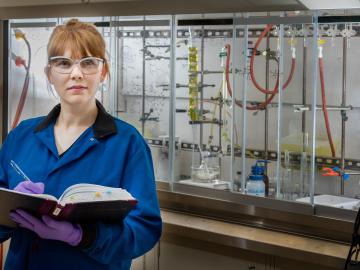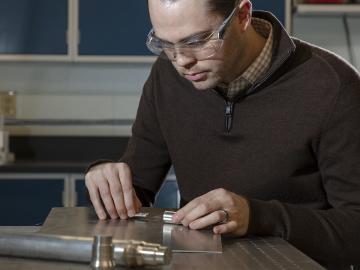
Filter News
Area of Research
- Advanced Manufacturing (4)
- Biological Systems (1)
- Biology and Environment (3)
- Building Technologies (1)
- Clean Energy (44)
- Climate and Environmental Systems (2)
- Computational Engineering (1)
- Computer Science (7)
- Fusion Energy (4)
- Materials (27)
- National Security (3)
- Neutron Science (16)
- Nuclear Science and Technology (9)
- Quantum information Science (2)
- Supercomputing (18)
- Transportation Systems (1)
News Type
Date
News Topics
- 3-D Printing/Advanced Manufacturing (11)
- Advanced Reactors (6)
- Artificial Intelligence (9)
- Big Data (7)
- Bioenergy (4)
- Biomedical (3)
- Biotechnology (1)
- Clean Water (4)
- Composites (1)
- Computer Science (26)
- Cybersecurity (1)
- Energy Storage (7)
- Environment (14)
- Exascale Computing (1)
- Fusion (3)
- Grid (4)
- Machine Learning (4)
- Materials Science (10)
- Mercury (1)
- Microscopy (2)
- Molten Salt (1)
- Nanotechnology (3)
- Neutron Science (12)
- Nuclear Energy (14)
- Physics (3)
- Polymers (1)
- Quantum Science (5)
- Space Exploration (4)
- Summit (6)
- Sustainable Energy (3)
- Transportation (10)
Media Contacts

Sometimes solutions to the biggest problems can be found in the smallest details. The work of biochemist Alex Johs at Oak Ridge National Laboratory bears this out, as he focuses on understanding protein structures and molecular interactions to resolve complex global problems like the spread of mercury pollution in waterways and the food supply.

An online tool developed by researchers at Oak Ridge National Laboratory provides architects and engineers a fast and efficient way to assess the performance of a building’s envelope design before construction begins.

Researchers have pioneered a new technique using pressure to manipulate magnetism in thin film materials used to enhance performance in electronic devices.

Oak Ridge National Laboratory physicists studying quantum sensing, which could impact a wide range of potential applications from airport security scanning to gravitational wave measurements, have outlined in ACS Photonics the dramatic advances in the field.

In the shifting landscape of global manufacturing, American ingenuity is once again giving U.S companies an edge with radical productivity improvements as a result of advanced materials and robotic systems developed at the Department of Energy’s Manufacturing Demonstration Facility (MDF) at Oak Ridge National Laboratory.

An organic chemist at Oak Ridge National Laboratory, Santa Jansone-Popova focuses on the fundamental challenges of chemical separations that translate to world-changing solutions for clean water and sustainable energy.

For the first time, Oak Ridge National Laboratory has completed testing of nuclear fuels using MiniFuel, an irradiation vehicle that allows for rapid experimentation.

A study led by Oak Ridge National Laboratory explored the interface between the Department of Veterans Affairs’ healthcare data system and the data itself to detect the likelihood of errors and designed an auto-surveillance tool

Scientists have discovered a way to alter heat transport in thermoelectric materials, a finding that may ultimately improve energy efficiency as the materials

With operating licenses for nearly all nuclear power plants set to expire in the 2030s and 40s—a pending loss that would affect a fifth of the country’s electricity supply—U.S. utilities will need to find a way to respond to what has been called the “nuclear cliff.”


